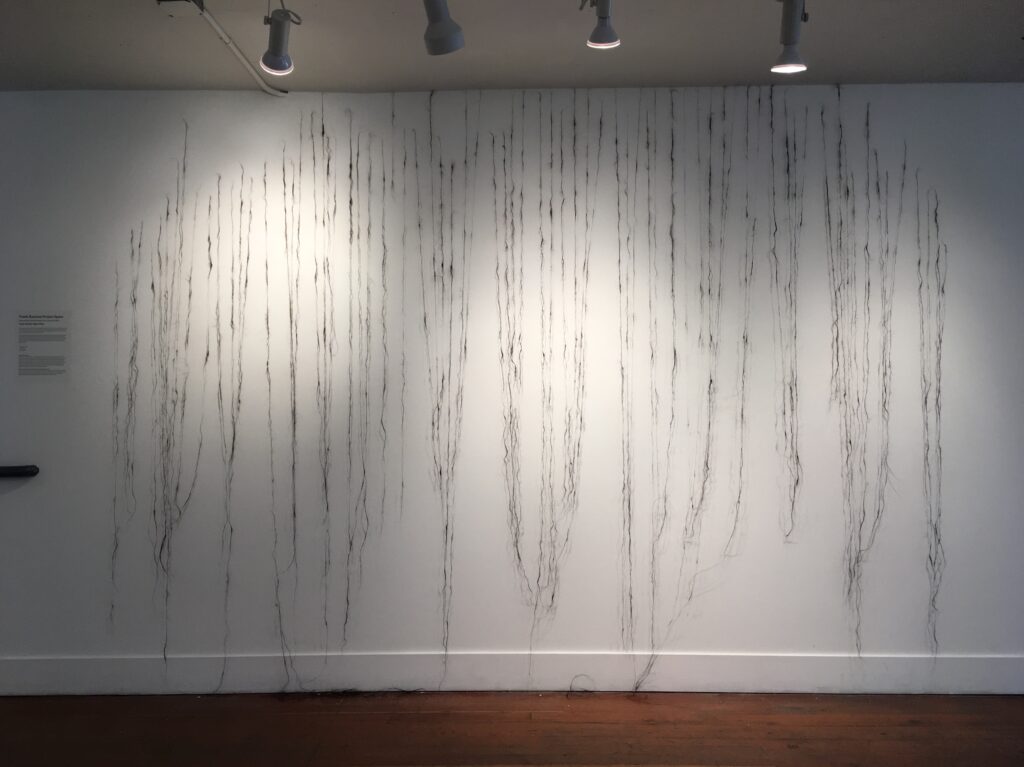
Over the past two years, Katie Revilla has collected strands of her lost hair, a process initially started as a way for her to archive a small part of her body that she loses on a daily basis. For Revilla, this mode of visual documentation has turned into a deeper understanding of the dissociation and rejection of her own body and the way it can amass space larger than itself. This led to her work Mane/Mine which currently hangs in the Frank-Ratchye Studio Artist Project Space for the month of September.
Revilla recently interviewed with Sherwin Rio (Exhibitions Fellow) to discuss how time, ritual, and specificity contribute to her art-making process.
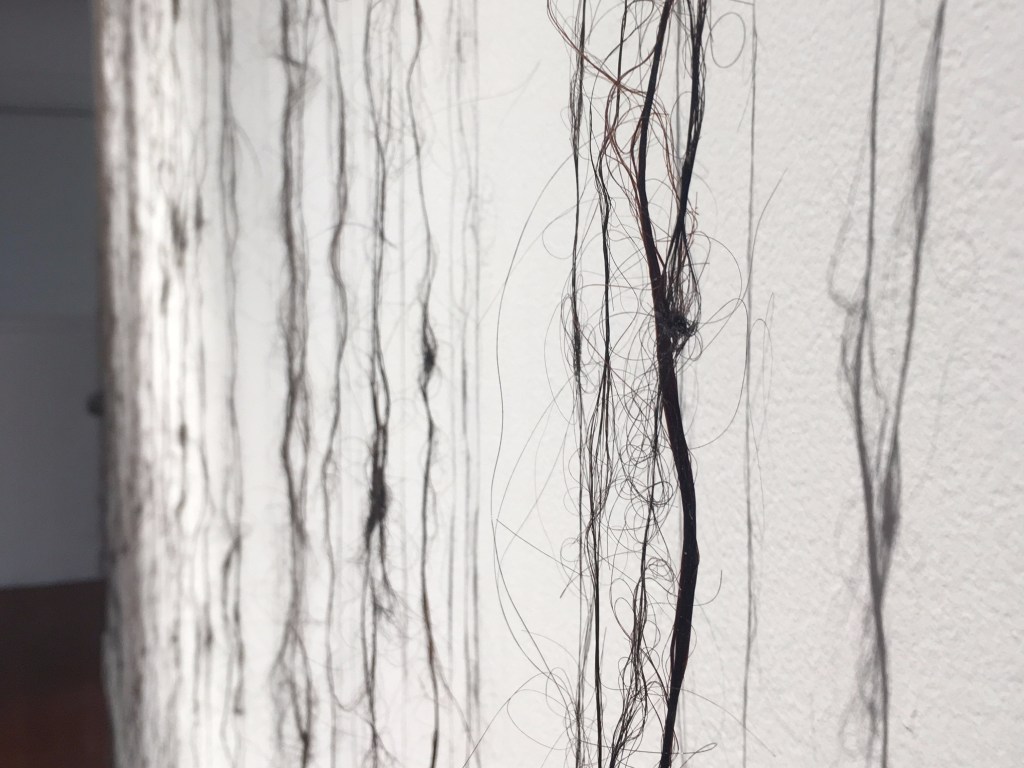
Sherwin Rio (SR): Katie, could you speak a little bit about where you’re from and how you first got involved in the arts?
Katie Revilla (KR): I’m actually from the Bay Area. We moved around a lot when I was a kid, but I mostly grew up in the San Jose. Its influence is such a huge part of me. I was really shy growing up, and also had a lot of trouble with letters and numbers. My first art class I took in high school actually changed my life. For the first time, I felt connected to a way of learning. That’s when I realized how much I loved expressing myself in a non-traditional way. Ever since that moment, I knew I wanted to be involved in the arts and went on to study it in college.
SR: And you studied at UC Berkeley right?
KR: Yes!
SR: What’s your studio process like?
KR: I actually look at my studio as a process. It’s the place where I can work out thoughts and ideas that are eating at me, and really make space to sit with them. I also work really intuitively with my practice. Once I have a material I’m excited about, I start to dissect it until it starts to become something. Or maybe nothing comes from it. When I start making, I start learning what the material can and can’t do, which is always really exciting. But most importantly, I think it’s the space to try new things. To fail and fail again is the most significant part of my process.
SR: Can you speak a little bit about how you use objects and locations that seem highly personal or specific? For instance, capturing the rust of your grandfather’s and father’s tools on silk, using your own personal pillows in sculpture, and noting the exact location an object was found?
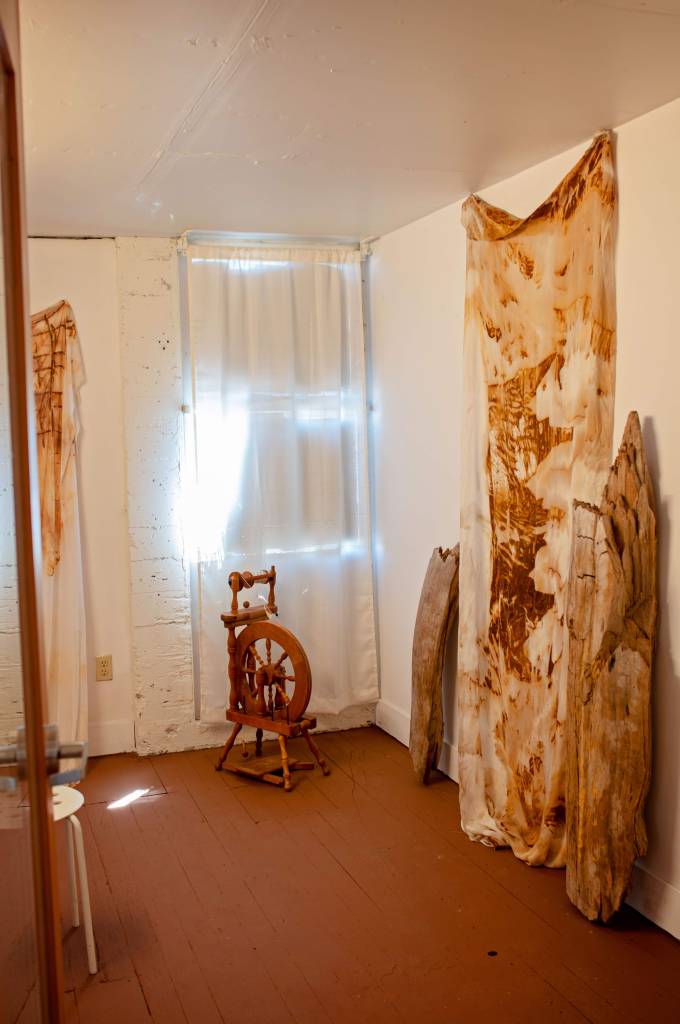
KR: My work is driven from specific memories, places, and times in my life that have deeply affected me in some way. I am driven to make work from my connection to these memories, but I also don’t think it limits my work’s ability to address larger issues or others from connecting to it but in a different way. And since my work is so heavily influenced by documentation and marking, I don’t think it would have the same impact if it wasn’t highly specific. Every time I make work, I think about my connection to the object I’m making. If I don’t have any sort of connection or investment in the object, then– is it going to become something that I actually care about making? If I tell you the work is from my own personal pillowcase compared to any other pillowcase, the narrative of the work changes.
SR: Thinking of some of your work from 2016 and onward, how does collaboration fit into your practice?
KR: Collaboration, metaphorical or physical, is something I’m really interested in. Since I work with my father’s and grandfather’s tools, I see all of that work as a generational collaboration. I also think a lot about a material’s origin: who might have made it, how many hands touched it before mine. I’ve also done collaborations with people wearing the works that I make and that is much more physical.
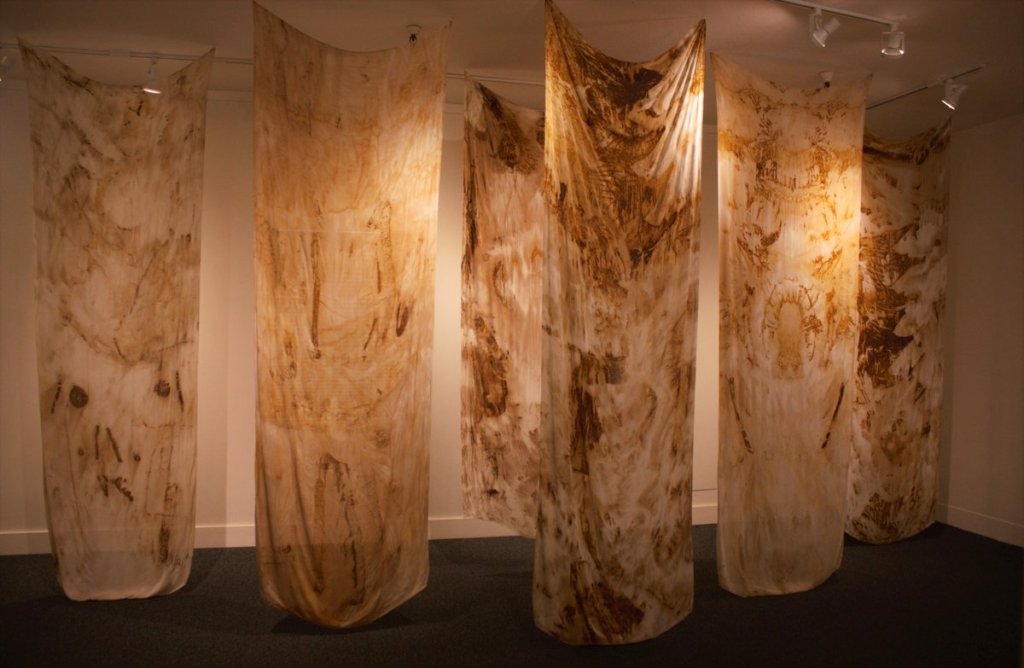
SR: Your work seems to be centered around markers of time and weight, can you talk a little bit more about the importance of time in your pieces?
KR: I could probably write a whole essay on the importance of time in my pieces. But I think it goes back to the idea of marking your place in a specific moment. It is about history, your history, personal history, how we are placed in the world and how we are made to be who we are. That is all about time and timing. Because my work is also highly involved in generations of my families, time becomes this major marker of history. It is a way to track when my grandfather came from the Philippines to San Francisco. When I was born, when we die, what we do, when we eat/sleep/drink/work, it is all centered around time so I think it is inevitable that this idea would translate to my work. Especially in natural fiber dyeing, the whole process is centered around time and letting things sit together. Rust itself is a material I’m so interested in because it is such a distinct marker of aging, changing, and loss.
SR: This way of thinking around your process seems deeply tied to ritual and ceremony. Would you say that’s also present in your work at all?
KR: Both of these concepts heavily tie into my work. The collecting of my hair is a major ritual for me. A lot of my day-to-day life is heavily grounded in ritual as well because I have Obsessive Compulsive Disorder. The compulsions that drive me to do everyday tasks in such a ritualistic way naturally drives my work that direction as well. My work has also been performative, including Burden, where I wore a plaster gown that was over 60 pounds around. Overall, I think ritual and ceremony are both interesting ways to address social constructs and ideas and see what these really formal concepts turn into when they become personal.
SR: Speaking of Burden, how did you begin making objects for wearing?
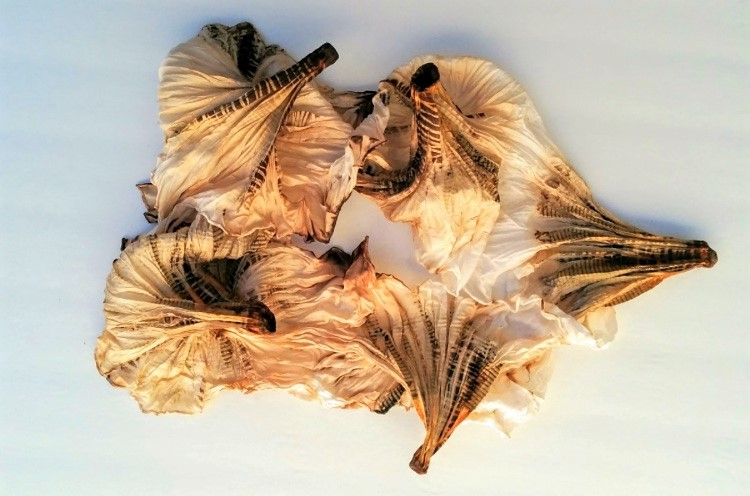
KR: Since I was interested in textiles, I naturally gravitated towards becoming interested in wearing, and challenging the idea of wearing. I see textiles as the house of the body,so I think it starts to become an interesting conversation between comfort and uncomfortability, and how to challenge these ideas. Specifically with the relationship between bodies and how they hold “Burdens”, I conceptualize ideas of conforming and constraining in order to retain power.
SR: Mane/Mine seems to be a point of departure from your previous fabric work, while remaining within the visual conceptual realm of the threaded textile. Can you tell us how that transition took place?
KR: Working with my hair has been something I’ve wanted to do for a long time. Being a textile artist and my work coming from a very personal place, I couldn’t imagine a better fiber than hair. This work comes from such a similar place as my other work does in terms of documenting time, change, and loss. Over the course of two years, every time I brushed my hair I put the hair from my brush in a jar. It became such a habit I didn’t even think about it, until I had a whole drawer full of jars of my hair. That’s when I felt like it was finally time to let go and use it.
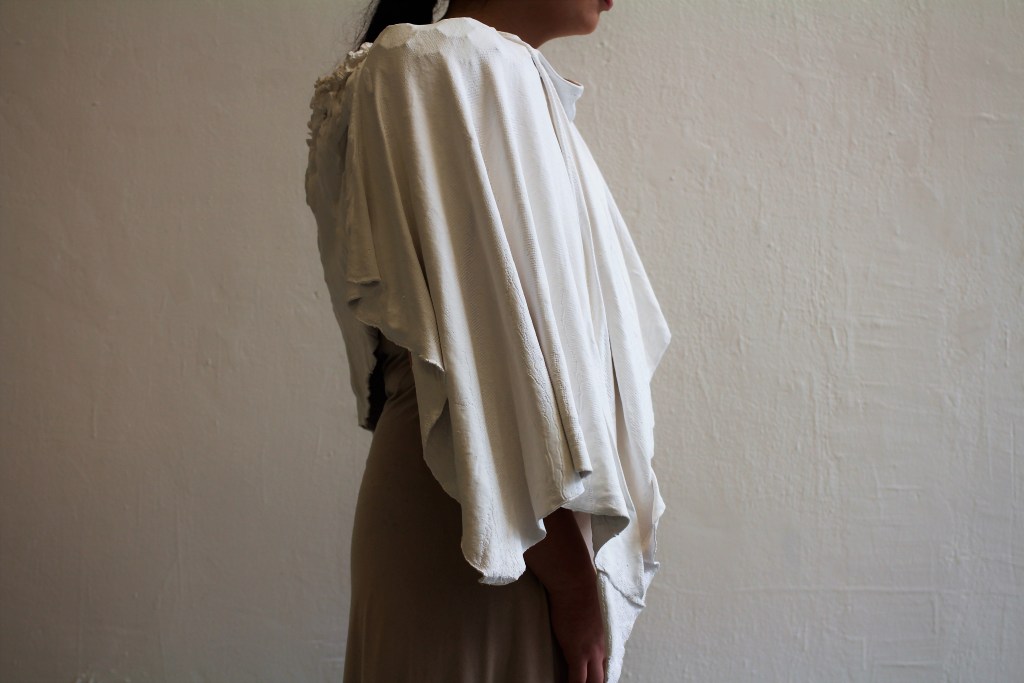
SR: How has your work evolved since being at Root Division?
KR: I’ve been given so many opportunities already being at Root Division. It’s felt really amazing to be given a space to continue my practice, along with opportunities like this one, where I can make site-specific work. It’s not that easy to find spaces that are welcoming and open to someone making work that you haven’t even made yet, so I feel really lucky that they trust me enough here that I can take risks.
SR: Lastly, what’s next for you? Do you have any projects, shows, or events you want to tell us about?
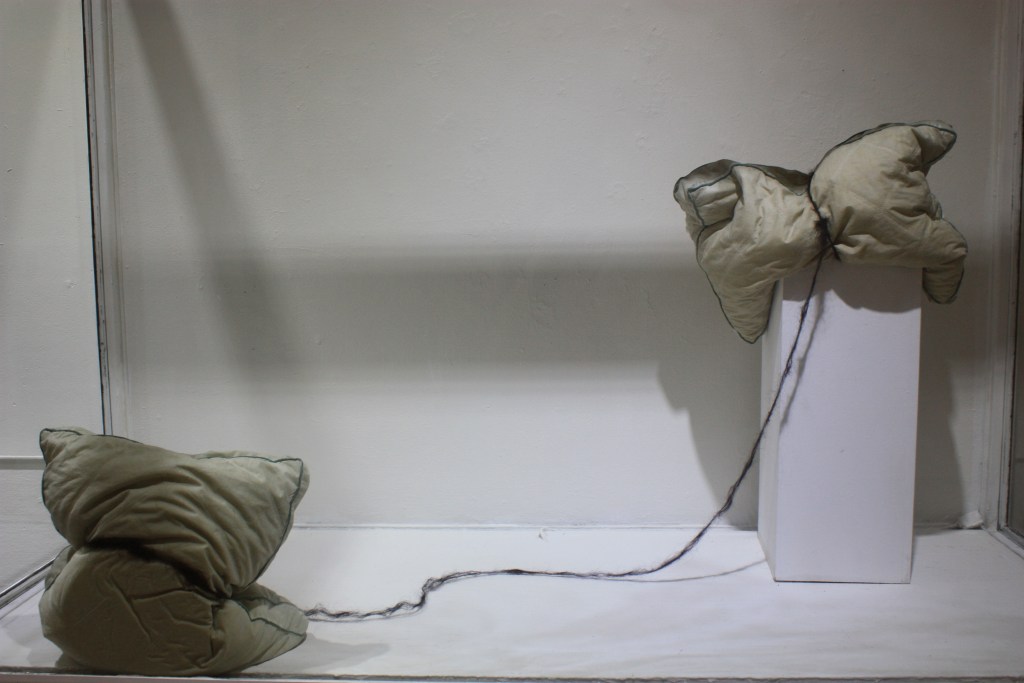
KR: I’m going to have some of my work at the Drip + Draw event at CTRL+SHIFT on September 22nd. I’m also working towards a solo exhibition I’m going to have in January!
